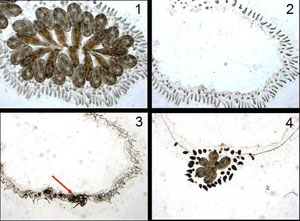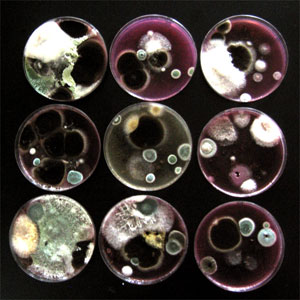 |

For further MBL News and Media Information, contact the MBL Communications Office at (508) 289-7423 or e-mail us at comm@mbl.edu
FOR IMMEDIATE RELEASE: August 27, 2008
Contact: Diana Kenney, MBL, 508-289-7139; dkenney@mbl.edu
August 2009 LabBits: Science Highlights from the MBL
MBL, WOODS HOLE, MA—How an extract from licorice root may prevent or delay prostate cancer … How a sea creature that can regrow its entire body in 48 hours … How fungi may affect the fate of a coral that lives in waters off Woods Hole …These are just three of the fascinating questions that scientists at the Marine Biological Laboratory (MBL) are exploring this summer. Summer on Cape Cod is synonymous with a surge of tourists, but also a surge of visiting scientists at the MBL. Researchers enjoy the casual, collaborative atmosphere, the access to high-tech equipment and expertise, and the escape from academic duties at their home institutions. Here is a sampling of some of the research underway this summer at the MBL’s Whitman Center for Visiting Research:
IN THIS ISSUE:
|
 |
 |
|
Kimberly Jackson cultures prostate cancer cells, which will be stained with fluorescent markers and imaged under the microscope. Some will be treated with the licorice extract DBM to study how the compound inhibits cell proliferation. Photo by Tom Kleindinst
|
Natural Product Gives Hope for Slowing Prostate Cancer
A compound from a simple, natural source – licorice root – may slow the growth of prostate cancer cells, even in late stages of the disease.
Kimberly M. Jackson, a MBL Research Fellow and an assistant professor of chemistry at Spelman College in Atlanta, first discovered the surprising ability of the licorice root compound (called dibenzoylmethane, or DBM) to inhibit prostate cancer.
“It’s working,” she says. “How it works is the question.”
The action of DBM potentially centers on the androgens, the class of hormones that includes testosterone. In both healthy and cancerous prostate cells, when the androgen attaches to its protein receptor, it kick-starts cell division. Currently, many doctors treat early-stage prostate cancer by blocking the androgen receptor, which initially slows the spread of the cancer. But in later stages of the disease, anti-androgen therapy stops working and the cancer cells continue to proliferate. Jackson, however, has shown that DBM interferes with the androgen receptor even in these later stages.
At the MBL, Jackson is gaining insight into how DBM disrupts the androgen receptor by using the MBL’s advanced microscopy facilities. Though she loves researching the mystery of how and why DBM works, Jackson says that her interest in prostate cancer is also personal. Prostate cancer, which is the most common cancer in men in the United States, has affected her family.
“Prostate cancer is near and dear to me because I am from a family of all boys. I want our men to stay around, and to be healthy. My father is a prostate cancer survivor,” she says. “It’s a disease that we really need to pay attention to and understand.”
|
 |
 |
Here, the body of Botryllus schlosseri (1) is completely removed. (2) The remaining blood vessels begin to bud (3, indicated by the red arrow), and within days recreate a body and all its vital structures (4). Credit: Stefano Tiozzo.
|
|
How to Regrow a Body
Remove everything but the blood vessels of Botryllus schlosseri—the muscles, the nervous system, the digestive system—and in just 48 hours the whole animal will be back. From just a few blood cells, this colonial tunicate can complete regenerate its daisy-chain body. It pulls off this amazing feat using many of the same cells and genes found in its close relatives, the vertebrates. So why can Botryllus regrow a body, when we can’t even regrow a pinky?
To find out, Stefano Tiozzo, a postdoctoral researcher in the lab of Anthony De Tomaso at the University of California, Santa Barbara, has joined a team of scientists studying Botryllus at the MBL this summer, which includes Ulrich Kuern and Snjezana Rendulic of UC Santa Barbara and Robert Lauzon of Union College. Tiozzo is comparing the three ways Botryllus can “grow” an adult body: through the regenerative budding described above; through another type of budding called palleal budding; and through fertilization and embryogenesis. Tiozzo hopes to see whether stem cells initiate the budding processes, and to understand which genes direct the cells to precisely recreate tissues. Identifying the specific groups of cells involved is crucial. “This will bring us to the second step,” Tiozzo says, “where we can look at how conserved molecular pathways trigger this amazing plasticity.”
Regeneration in Botryllus could one day help explain why this ability was lost in most vertebrates. It may also provide insight on how human stem cells work, and perhaps even hint at how we can encourage our own cells to reclaim some of their regenerative legacy.
|
 |
 |
|
The temperate coral Astrangia poculata, or Nothern Star Coral. Credit: Marc Orbach.
|
|
 |
|
When possible, the team cultures fungal colonies like these using standard media. To identify fungal species that can’t be grown on plates in the lab, the team must find ways to amplify fungal DNA extracted directly from the coral. Credit: Oded Yarden
|
Coral’s Fungal Residents
Inside every coral is an abundance of bacterial and fungal species. Bacteria associated with corals have gained much attention. But little is known about their fungal neighbors, even though fungi may have beneficial and detrimental impacts on coral health, and fungi have been linked with diseases of coral in the tropics. The impact of fungi on temperate corals, and how climate change might alter fungal-coral associations, has hardly been investigated.
This summer at the MBL, Oded Yarden, a professor at The Hebrew University of Jerusalem, and graduate student Lena Hazanov, who are supported by MBL Gruss-Lipper Fellowships, along with Marc Orbach and Alejandra Mandel from the University of Arizona, are the first group to systematically study these questions. The team is working to identify and determine the relative abundance of fungal species in sick and healthy specimens of Astrangia poculata, a coral abundant off the coast of Woods Hole. To do this, the team uses classical culturing methods as well as amplification of fungal DNA directly from the corals, to isolate the fungi that cannot be grown on traditional media in the lab. They are also tracking shifts in resident fungal populations in corals exposed to increasing temperatures, to see if fungi proliferate and damage the coral when it’s stressed. “A lot of the fungi we’ve found do well at higher temperatures,” Yarden says. “The adaptive capacity of the fungi far exceeds that of the coral.”
Understanding fungal associations with Astrangia could help in monitoring coral health under changing environmental conditions. Coral-associated fungi, some of which are new to science, may also produce novel chemical compounds with potential benefits to human health.
|
The MBL is a leading international, independent, nonprofit institution dedicated to discovery and to improving the human condition through creative research and education in the biological, biomedical and environmental sciences. Founded in 1888 as the Marine Biological Laboratory, the MBL is the oldest private marine laboratory in the Americas. For more information, visit www.MBL.edu.
|